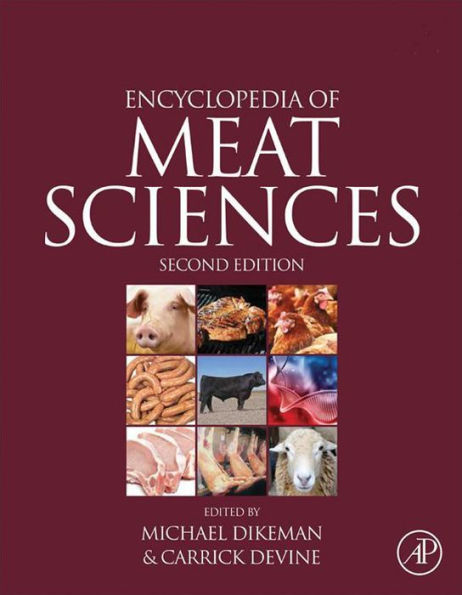Table of Contents
Extenders
Functional
DNA Markers and Marker-Assisted Selection in the Genomic Era
Traditional Animal Breeding
Animal Health Risk Analysis
Cutting and Boning
Slaughter Line Operation
Bacon
Wiltshire Sides
Biofilm Formation
Biomethane Production and Cleanup
Biopreservation
Cloning
Genetically Modified Organisms in Meat Animal Production
Boar Taint: Biological Causes and Practical Means to Alleviate It
Edible, for Human Consumption
Hides and Skins
Inedible
Canning
Carcass Chilling and Boning
Carcass Composition, Muscle Structure, and Contraction
Analysis of Final Product Composition for Labeling
Physicochemical Analysis Methods
Raw Material Composition Analysis
Sampling and Statistical Requirements
Standard Methods
Curing Agents
Major Meat Components
Micronutrients and Other Minor Meat Components
Veterinary Drug Residue Analysis
Adipose Tissue
Chemical composition
Color and Pigment
Palatability
pH Measurement
Protein Functionality
Water-Holding Capacity
Emulsions and Batters
Nonmeat Proteins
Other Ingredients
Spices and Flavorings
Beef Carcass Classification and Grading
Pig Carcass Classification
Connective Tissue: Structure, Function, and Influence on Meat Quality
Aging
Color and Texture Deviations
Glycogen
Glycolysis
Rigor Mortis, Cold, and Rigor Shortening
Slaughter-Line Operation and Pig Meat Quality
Cooking of Meat
Flavor Development
Heat Processing Methods
Maillard Reaction and Browning
Physics and Chemistry
Warmed-Over Flavor
Brine Curing of Meat
Dry
Natural and Organic Cured Meat Products in the United States
Physiology of Nitric Oxide
Production Procedures
Hot Boning of Meat
Traditional
Double-Muscled Animals
Drying
Economics: Meat Business and Public Policy
Electrical Stimulation
Environmental Contaminants
Environmental Impact of Meat Production: Primary Production/Meat and the Environment
Equipment Cleaning
Biltong: A Major South African Ethnic Meat Product
Brazil and South America
China and Southeast Asia
France
Germany
India and Pakistan
Japan and Korea
Mediterranean
Middle East
North America
Poland
Exsanguination
Extrusion Technology
Fermentation
Fish Inspection
Foodborne Zoonoses
Foreign Bodies
Functional Foods
Genome Projects: Modern Genetics and Genomic Technologies and Their Application in the Meat Industry - Red Meat Animals, Poultry
Adipose Tissue Development
Endocrinology
Growth Patterns
Metabolic Modifiers
Muscle
Physiology
Cooked Ham
Dry-Cured Ham
Hazard Analysis Critical Control Point and Self-Regulation
Cancer Health Concerns
Cardiovascular and Obesity Health Concerns
Macronutrients in Meat
Meat and Human Diet: Facts and Myths
Micronutrients in Meat
Nutraceuticals
Vegetarianism
Irradiation
Laboratory Accreditation
Manure Management
Waste Management in Europe
Measurements of Water-holding Capacity and Color: Objective and Subjective
Antibiotic Growth Promotants
Beta-Agonists
Bovine and Porcine Somatotropin
Disease Control and Specific Pathogen Free Pig Production
Exotic and other Species
Meat Production in Organic Farming
Poultry
Red Meat Animals
Meat-Borne Hazards, Concepts and Methods for Mitigating Risks Related to
Cold Chain
Market Requirements and Specifications
Transport of Meat and Meat Products
Wet Markets
Meat Pricing Systems
Meat Research Institutions
Meat Species Determination
Mechanically Recovered Meat
Decontamination of Fresh Meat
Decontamination of Processed Meat
Microbial Contamination of Fresh Meat
Microbial Contamination of Processed Meat
DNA Methods
Indicator Organisms in Meat
Standard Methods
Aeromonas spp.
Bacillus cereus
Clostridium botulinumand Botulism
Clostridium Perfringens
Emerging Pathogens
Hurdle Technology
Listeria monocytogenes
Pathogenic Escherichia coli
Prions
Salmonella spp.
Staphylococcus aureus
Thermotolerant Campylobacter
Viruses
Yeasts and Molds
Yersinia enterocolitica
Antibiotic Resistance by Microorganisms
Potential Environmental and Wildlife Sources of Microorganisms in Meat
Minced Meats
Meat Quality
Microbiology
Refrigeration
Muscle Fiber Types and Meat Quality
Nutrient Claims on Packaging
Pigs
Poultry
Ruminants
On-line Measurement of Meat Composition
On-line Measurement of Meat Quality
Equipment
Modified and Controlled Atmosphere
Overwrapping
Technology and Films
Vacuum
Parasites Present in Meat and Viscera of Land Farmed Animals
Patenting Products, Processes, and Apparatuses
Other Physical Measurements
Temperature Measurement
Potential Chemical Hazards Associated with Meat
Prediction of Meat Attributes from Intact Muscle using Near-Infrared Spectroscopy
Preservation methods of Animal Products
Behavior of Cattle, Pigs, Sheep, Bison, and Deer during Handling and Transport
Design of Stockyards, Lairages, Corrals, Races, Chutes, and Loading Ramps
Preslaughter Handling
Welfare Including Housing Conditions
Welfare of Animals
Battering and Breading Equipment
Brine Injectors
Mixing and Cutting Equipment
Smoking and Cooking Equipment
Tumblers and Massagers
Professional Organizations
Proteomic Technologies and Their Applications in the Meat Industry
Abattoirs and Processing Plants
Farm Level: Pork Quality
Farm Level: Safety and Quality of Beef
Applications
Equipment
Freezing and Product Quality
Principles
Thawing
Religious Slaughter
Feed and Drug Residues
Residues Associated with Meat Production
Risk Analysis and Quantitative Risk Management
Sausage Casings
Cooked
Dry and Semidry
Emulsion
Fresh
Sensory and Meat Quality, Optimization of
Sensory Assessment of Meat
Slaughter, Ethics, and the Law
Cattle
Other Species
Pigs
Poultry
Sheep and Goats
Liquid Smoke (Smoke Condensate) Application
Traditional
Cattle
Finfish
Game and Exotic Animals
Meat Animals, Origin and Domestication
Pigs
Poultry
Sheep and Goats
Shellfish
Microbiological
Oxidative and Enzymatic
CO2 and Other Gases
Electrical Stunning
Mechanical Stunning
Slaughter: Immobilization
Stunning and Killing of Farmed Fish: How to put it into Practice?
Sustainable Muscle Foods Industry
Chemical
Enzymatic
Mechanical
Tenderness Measurement
Thermophysical Properties



